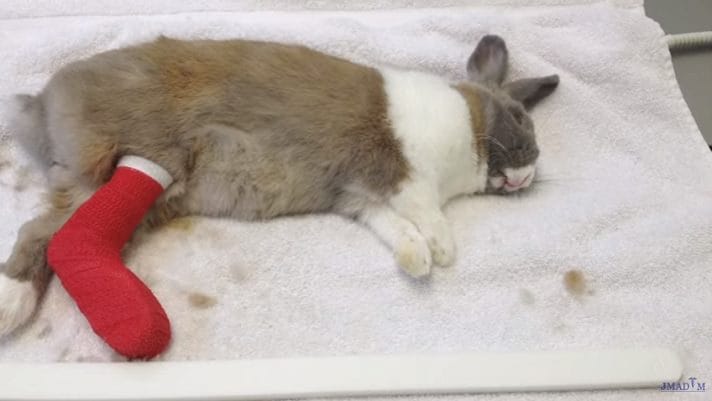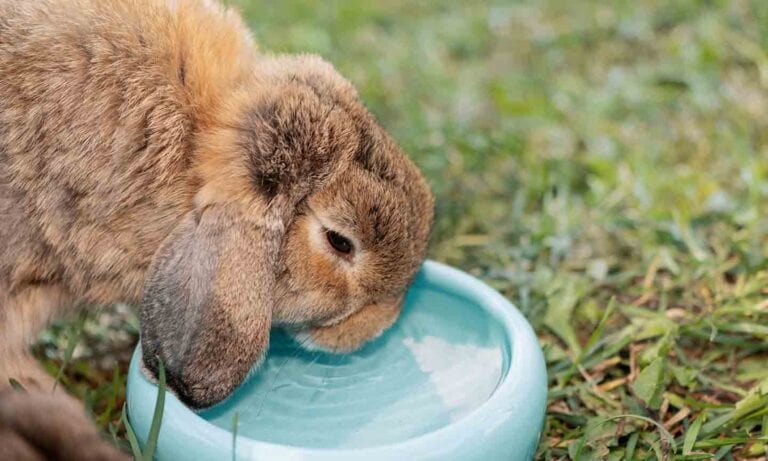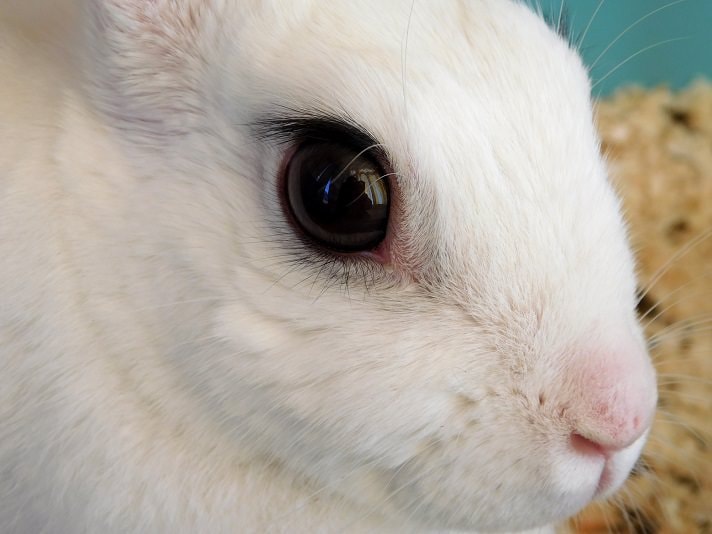Rabbits are amazing creatures that provide companionship and joy for many families. Part of our job as caretakers is keeping our rabbits safe from harm. Traumatic injuries are fairly common in pet rabbits, and in many cases may be avoidable. Make sure to do your homework so you know how to keep your rabbit safe and what to do in the unfortunate situation that your rabbit suffers an injury. This article will review some common injuries and how to address them, as well as some helpful tips on rabbit first aid and rabbit-proofing your home.
1. Torn Toenail
Torn toenails are probably one of the most common injuries seen in rabbits. The toenail may catch on something and be ripped out at the base. This is often accompanied by bleeding and an upset rabbit (not to mention rabbit caretaker!).
Fortunately these injuries may not require extensive care. If the nail is completely ripped off, some gentle pressure applied to the area for 1 to 2 minutes helps stop the bleeding. If some visible nail remains, use styptic powder or flour to help stop the bleeding. In some rare cases the exposed tissue can develop an infection. If you see any redness or swelling develop, have your veterinarian evaluate the area.
Preventing Toenail Injuries
You can generally prevent toenail injuries by trimming your rabbit’s nails on a regular basis. It is also helpful to avoid bedding materials with fibers that can encircle the nail.
2. Crushing Wounds
Accidents unfortunately happen. People get in a rush, doors get slammed, pets get startled and sometimes there are unfortunate collisions between your rabbit and dangerous objects. Crushing and penetrating wounds are fairly common accidents. The best “treatment” is to prevent them from happening in the first place.
Always check doors before opening and closing, but if you forget and your rabbit gets caught in the door, monitor him closely after any accident. If you see any bleeding, take your pet to a veterinarian immediately, because a fracture or internal damage is possible.
On occasion we see rabbits that experience a trauma and seem perfectly fine — but always monitor a rabbit very closely for any signs of problems. If your rabbit has any bleeding, difficulty breathing, lameness, or change in appetite or fecal production, it is best to have a veterinarian evaluate your rabbit.
Preventing Crushing Wounds
Check to make sure you have carefully rabbit-proofed the area where your rabbit lives. Make sure family members check doors before opening and closing to make sure there are no rabbits nearby. Be aware that reclining chairs, foldout beds, and other heavy moving objects could pose risks to rabbits, so keep rabbits away from potential hazards to avoid accidents.
3. Penetrating Wounds
Penetrating wounds can happen when a sharp object penetrates your rabbit’s skin. Sharp wires or edges on cages are most often to blame. Keep in mind that the skin of your rabbit has bacteria that can cause problems if a penetrating object transfers those bacteria to the deeper tissues. If your rabbit has a penetrating wound, have him evaluated by a veterinarian to determine if antibiotics or surgery may be necessary. While you can clean a surface wound with a small amount of witch hazel or saline (avoid using peroxide on penetrating wounds) with minimal risk, this does not address bacteria that may be below the surface of the skin. Also, if your rabbit has any damage to the eye surface (such as a scratch) make sure to get your rabbit to the veterinarian immediately for treatment, because infections of the surface of the eye can progress rapidly.
Preventing Penetrating Wounds
Check to make sure you have carefully rabbit-proofed the area where your rabbit lives. Check for any sharp wires or objects that could cause injury. It is a good idea to move around the room at the eye level of your rabbit (although you might look a little funny crawling around on the floor!) to check for low hazards you may not notice if you are standing. If your rabbit experiences any trauma around or in the eyes, get to the veterinarian right away.
4. Fractures
Back and leg fractures are all too common in pet rabbits and can be the result of improper handling. Remember that the bones of rabbits are delicate in comparison with their muscle mass. Did you know that the skeleton of a rabbit only comprises about 7 or 8 percent of body weight (as opposed to 12 or 13 percent in cats)? And did you know that a rabbit’s muscle mass is greater than 50 percent of the body weight? Rabbits have very powerful hind leg muscles, and a single kick can result in a back or leg fracture if the rabbit’s body is not properly supported during handling.
Back Fractures
The most common cause of sudden paralysis of the hind legs of a rabbit is back fracture. The most common fracture site is in the lumbar section of the back. If your rabbit suddenly loses ability to move his back legs, get him to a veterinarian as soon as possible for testing, including radiographs (X-rays).
If your rabbit does not have any sensation in his toes (a veterinarian will check this by pinching on the toes to test response) the prognosis for recovery is poor. Rabbits do not tolerate back surgery as well as other animals, so surgical options for back injury may be limited. Strict cage rest and a course of nonsteroidal anti-inflammatories may be recommended to allow healing of injured tissues. There has been at least one report of a rabbit recovering with no deep pain response with supportive care measures only (i.e., no surgery), so recovery from back fracture is possible.
If your rabbit has no sensation in his back legs and no bladder function (your veterinarian can determine this), the most humane decision may be euthanasia. Rabbits with back injuries may need intensive supportive care measures to avoid pressure ulcers and skin damage from urine and fecal soiling. In cases of permanent paralysis, some rabbits can adapt to using a cart to allow movement.
Leg Fractures
Severe limping or inability to use a leg can be a sign of a leg fracture. If you note this in your rabbit, get to a veterinarian as soon as possible for testing, including radiographs, to determine if a fracture is present. Depending on the type of fracture, surgery may be recommended. Surgical options for leg fractures may include pin placement or plating. Your veterinarian may refer you to a specialist to address more challenging fractures.
If a fracture is open with exposed bone, immediate wound care and surgery is required to avoid infection. Bandaging can be helpful to stabilize a fracture and prevent further damage prior to surgery. While it is possible for some fractures to heal with bandaging or cage rest only, your veterinarian will need to take radiographs to determine the best treatment recommendation. If fracture repair is not possible, amputation may be recommended in some cases. The bottom line is that prevention of a fracture in the first place is really your best bet!
Preventing Back And Leg Fractures
Make sure to use nonskid surfaces under your rabbit, especially during handling. Always support the hind end carefully when picking up your rabbit. It is good practice to get in the habit of supporting across your rabbit’s chest with one hand and supporting the hindquarters with another. Alternatively you can carry a stressed rabbit with his head tucked under your arm while supporting the hind end.
If you are placing a rabbit down or in a cage, make sure his rear is facing the back of the cage while supporting the back end to avoid the rabbit kicking. If your rabbit is kept in a cage, check it carefully for areas where a leg could be entrapped. Also keep in mind that cages with high multiple levels are not ideal for rabbits, because they can be prone to injury if jumping up and down off high levels. Many rabbits sustain injury when being placed through the doors of rabbit cages, so make sure your rabbit’s body is well supported when putting him in and out of a cage, or allow him to hop in and out on his own.
5. Falls
We have seen injury resulting in euthanasia of a pet rabbit from a fall as little as 2.5 feet. Falling from any distance can cause injury to your rabbit, so rabbit-proof your house to avoid falls. Rabbits should be housed in an area that provides ample horizontal space, but minimal vertical platforms (unless they are very low) to avoid the potential for falls. I have known rabbits that have experienced falls and remain uninjured, but always watch a rabbit closely if he experiences a fall. Any bleeding, limping, difficulty breathing or changes in behavior are signs your rabbit should be evaluated by a veterinarian right away.
Preventing Falls
Make sure everyone in the household (especially children) is aware of proper handling technique. Do not allow your rabbit to jump onto beds or other furniture. Keep your rabbit away from staircases. If your rabbit is in any potentially dangerous situation (even on a table at a veterinary clinic), always make sure someone has control of the rabbit to prevent jumps or falls.
6. Bite Wounds
Any bite wound to a rabbit from a dog or cat (or any predator) requires immediate attention. Carnivores have bacteria that reside in their oral cavity that can cause life-threatening infection in your rabbit if he is bitten. If this occurs, get your rabbit to a veterinarian immediately for wound assessment, treatment and antibiotics as soon as possible.
Keep in mind that your rabbit’s fur may hide the extent of wounds, so check for areas of wet or matted fur that may indicate the location of a wound. Bites from another rabbit may not have the degree of concern about infection as a carnivore wound, but infection is still possible, so evaluation by a veterinarian is best.
Ear wounds or wounds around the nose may not be as crucial to address as quickly as trauma around the eyes. Eyelid lacerations or wounds are best repaired to make sure the eyelids close properly and allow protection of the delicate structures of the surface of the eye (cornea). Corneal trauma can progress to vision-threatening infection if not treated, so take all eye injuries very seriously.
Preventing Bite Wounds
Never leave your rabbit where a dog, cat or other predator can reach him. Even the best pets have been known to attack rabbits, so always err on the side of caution. Make sure new rabbits are properly bonded and acclimated before leaving them unsupervised. If a rabbit shows a repeating pattern of attacking another rabbit, “forced bonding” of the pair can result in serious injury.
7. Grooming Injuries
If you groom your rabbit or take your rabbit to a groomer, make sure he or she is experienced with rabbits. Rabbits are a prey species, so they can become very stressed (to the point of death) if kept in close proximity to noisy predators. There aren’t many situations where a grooming facility would not stress a rabbit, so if dogs or cats are in the vicinity it may be best to avoid the scenario altogether.
Compared to dog and cat skin, rabbit’s skin is very delicate and easily damaged. I have seen situations where a rabbit’s tail has literally been amputated by someone attempting to remove matted hair, not realizing they were cutting off the tail. Don’t assume that someone who grooms dogs and cats will know the unique needs of your rabbit!
Prevention Of Grooming Injuries
Make sure anyone grooming your rabbit has experience with rabbits and avoid leaving your rabbit in an area with dogs, cats or other predators. Unless you are experienced, avoid using clippers or scissors on fur mats to avoid injury to the delicate skin. You may want to speak with your veterinarian if your rabbit has extensive mats of fur that need to be removed. Brush your rabbit regularly to remove excess fur. Try to schedule time with someone experienced with grooming rabbits for tips on trimming fur if this is needed to keep your rabbit in tip-top shape.
8. Toxin Exposure
While toxin ingestion or application is not technically a traumatic event, it still bears mentioning. Remember that fipronil (Frontline is a brand name) is toxic when applied to rabbits. In addition, topical pyrethrins or permethrins sold over the counter can be toxic to your rabbit, so check with your veterinarian before using any over-the-counter insecticide on your rabbit.
Rabbits may seek out household toxins because they are attracted to the taste. For example, lead poisoning is common in rabbits that chew on walls or baseboards in older homes with lead-based paint, the lead tastes sweet so rabbits may seek this out. We have also seen rabbits that ingested rat poison, marijuana, and other potential toxins. Always keep in mind that your rabbit won’t know to avoid ingesting toxic substances.
Prevention Of Toxin Exposure
Make sure you know potential toxins that can hurt your rabbit. Make sure to properly rabbit-proof your home. Get at-home lead test kits to check your house for lead-based paint. Do not use rat bait; not only is this toxic to your rabbit if ingested but it is toxic to animals such as wildlife that may eat a rat or mouse that has ingested rat poison. Make sure you do not have toxic plants around rabbits.
9. Electrocution
Electrocution injury is possible in any rabbit that has potential exposure to electrical wires. Electrocution injuries are not always obvious, especially if the incident happens when you are not around. Suspect electrocution if your rabbit has exposure to wires, especially if you see teeth marks on an electrical cord and your rabbit suddenly stops eating.
Electrocution can cause painful burns around the mouth that may not be immediately obvious but can become more visible over a period of days. In severe cases, electrocution can also cause fluid to build up in the lungs and difficulty breathing or death.
If you suspect your rabbit has been electrocuted, have him evaluated by a veterinarian as soon as possible to determine the extent of injury. The best treatment for electrocution injuries is prevention!
Prevention Of Electrocution
Properly rabbit-proof your home such that your rabbit does not have access to any electrical cords. Keep cords out of reach or covered, or keep your rabbit out of rooms with cords.
10. Heat Stress
Rabbits are very sensitive to heat stroke or heat stress when exposed to environmental temperatures close to and above 85 degrees Fahrenheit. Heat stress should be suspected if your rabbit has been exposed to warm temperatures, and particularly if you see any of these signs accompanied by an elevated body temperature: weakness, depression, incoordination, convulsions and coma.
If rectal temperature on a rabbit exceeds 105 degrees Fahrenheit, immediately begin slow cooling by spraying the rabbit or wrapping him in cool (not cold), wet towels, using care to stop cooling measures once rectal temperature reaches 102 degrees Fahrenheit. Immediate veterinary care is recommended, because more aggressive supportive care measures may be needed, including fluids or medications to reduce swelling in the brain.
Prevention Of Heat Stress
Do not leave your rabbit in a car that is not air conditioned and take care to avoid temperature extremes if your rabbit is housed outdoors. Most of the heat stress cases I see are situations where an air conditioner malfunctions in the summer, so make sure to have cooling equipment serviced on a regular basis to avoid malfunction.
11. Urine Scald/Myiasis
Urine scalding itself is not considered a traumatic event, but rabbit caretakers may mistake wounds created by urine or fecal scalding around the tail as a trauma or injury. If a rabbit is housed in an outdoor rabbit hutch and has moisture from matted fur and urine or feces collecting around the tail region, flies can be attracted to this moisture. Myiasis, or fly strike, is a condition that can result when flies lay eggs on the skin and larvae, or maggots, hatch. This condition, or any situation that results in moisture collecting on the skin, should be evaluated to avoid wounds or infection.
Prevention Of Urine Scald/Myiasis
Make sure your rabbit does not have mats of fur around the tail. Any urine or feces collected around the tail should be examined by a veterinarian to evaluate for underlying disease. Rabbits that are on an improper diet and/or overweight will be prone to this condition, so weight loss or diet change may be recommended by your veterinarian.
By: Dr. Jennifer Graham, DVM, DABVP (Avian / Exotic Companion Mammal), DACZM
Feature Image: James Askew DVM/YouTube
More on Rabbit Health
Share:









